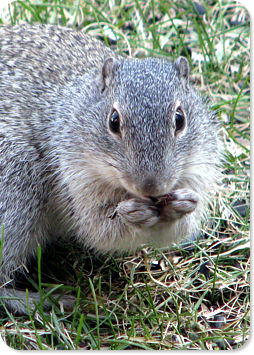 Animals possess true cold-coping abilities.(Published in the Winnipeg Free Press, Mar. 11, 2001) She was cold to the touch, curled into a ball as though asleep. There was no apparent heart beat or breathing. The next day she was running around and playing in her cage. No, I'm not talking about the "frozen baby" in Edmonton. I'm talking about a female Richardson's ground squirrel in a research lab at the U of M, back when I was a grad student. I'd been able to hold the hibernating squirrel in my hand and feel how cold it was. It's body temperature was only 5C, but it was in no danger. The handling and other stimuli were intended to break its dormancy, and it wasn't long before the squirrel began to shiver and warm itself back to life. Some mammals can shut down their metabolism and endure hypothermia as a means to save energy when environmental conditions, such as winter or drought, prevent them finding sufficient food. We call this period of controlled hypothermia, hibernation. Humans don't share this ability. The poor child that had somehow managed to stumble outdoors by herself in the middle of the night at -20C, didn't really "freeze solid", as was widely reported. She suffered severe hypothermia with extensive frostbite, which is actual tissue freezing, on her extremities. Humans are not freeze-tolerant, severely frozen tissue will not recover. Her core temperature (Tb), the temperature of her internal organs well inside the body, was still +16C. That's a long way from being frozen solid. When a human encounters severe cold, the rate of heat loss can exceed the body's ability to produce heat, even if normal metabolism is supplemented with activity or shivering. Once this point is reached, Tb, normally 37C, begins to drop. Hypothermia, a serious drop in Tb, is diagnosed at around 34C, only a 3C drop. As Tb drops further, shivering begins to decline, as the muscles begin to lose their ability to operate. A state of lethargy, called cold narcosis, develops in humans (and in other non-hibernating mammals) that experience severe hypothermia. This is why people who have succumb to hypothermia are usually found lying down as if asleep. Mercifully, they simply fall asleep before the cold overtakes them. At a Tb of about 19C respiratory failure occurs, the muscles of the heart and lungs stop working. Without removal from the severe cold and application of external warming, death will occur. The child in Edmonton reportedly had her heart stopped for 2 hours. No blood flow means no oxygen to the brain and heart. Normally, irreparable brain damage begins after only a few minutes of oxygen deprivation. The exception is cases like this where the core temperature drops rapidly, thanks to the extreme cold and her small size. Cooler organs require much less oxygen. An adult suffering that degree of hypothermia would be more likely to have had terrible brain damage and died. Hibernating mammals, such as ground squirrels, chipmunks and bats, can tolerate extreme hypothermia because their respiratory systems continue to work. Their hearts and lungs still function at Tb's near 0C, albeit at greatly reduced rates, but they keep the brain and other tissues supplied with oxygen. What's more, these animals have built-in temperature alarms if their Tb drops too far. Hibernators choose micro- environments, such as deep burrows or caves, where temperatures will not fall below freezing. Then they let their Tb drop to that of the surrounding environment. But if temperatures do drop too far, the animal will arouse and move, if possible, to a warmer location before resuming hibernation. Hibernators even have a special tissue in their body, called brown fat, that helps them warm up quickly. Brown fat is a unique fatty tissue containing extra blood vessels. It functions like a furnace to metabolize fat rapidly, releasing heat to warm the blood which then circulates throughout the body. Together with muscular shivering a hibernator can warm it's body back to normal Tb quickly, by as much as 20C in 1 hour! Hibernators have remarkable abilities to tolerate hypothermia, essentially becoming cold-blooded for long periods to save energy. We humans have little tolerance to changes in our Tb and can't recover from severe hypothermia on our own. When it's cold outside, bundle up! Thanks for reading! Got to the: < Previous Column | What's Outdoors Front Page | Next Column >
|
||
| You can help NatureNorth produce more great articles with a secure donation through PayPal. Our Google Adsense ads pay our server costs, but that's about it. To learn more follow this link: Support NatureNorth. Thank-you! | |
Return to the: NatureNorth.com Front Page
Or pick a seasonal issue to visit:
